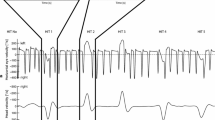Abstract
Binocular videonystagmography (VNG) was used to study the vestibulo-ocular response to a double rotation test as a pre-flight medical examination (PFME) for assessing an aircrew’s vestibulo-autonomic stability. The objective of our study was to identify the relationship between the degree of the nystagmus response to rotation and the severity of motion sickness (MS). The investigated cohort included 135 subjects selected from flight crews aged 23 to 47 years, who were qualified healthy according to the PFME criteria. The test used was based on the intermittent cumulation of Coriolis accelerations by Bryanov’s method. The post-testing vestibular reactivity was assessed using criteria for determining the level of autonomic reactivity and protection movements. Binocular videonystagmography (VNG) with a mask cover was performed during and after rotation. The degree of interocular asymmetry of nystagmus velocity was shown to be directly associated with the severity of MS. We suggested the following asymmetry coefficients: the asymmetry coefficient of unidirectional nystagmus during flexions (ACf) and extensions (ACe); and the duration of convergence rotatory nystagmus during flexions (DCNf) and extensions (DCNe). It has been found that ACf and DCNf are correlated with the severity of MS (p < 0.05). On the basis of our data, we formulated the idea of the mechanism for MS development due to double rotation, which was understood as the occurrence in these conditions of intravestibular interlabyrinth conflict.
Similar content being viewed by others
References
Bazarov, V.G., Klinicheskaya vestibulometriya (Clinical Vestibulometry), Kiev, 1988.
Bryanov, I.I., The method for studying the stability of the human vestibular analyzer to the cumulation of Coriolis accelerations, Voenno-Med. Zh., 1963, no. 11, p. 54.
Vorob’ev, O.A., The function of the vestibular apparatus as a gyroscopic system with double rotation, Izv. Akad. Nauk SSSR, Ser. Biol., 1984, no. 2, p. 259.
Vorob’ev, O. A., Chistov, S. D., and Rybachenko T. A., Convergence rotatory nystagmus under unusual conditions of semicircular canal and otolith stimulation, Hum. Physiol., 2009, vol. 35, no. 5, p. 569.
Vertigo, Dix, M.R. and Hood, J.D., Eds., New York: Wiley, 1984.
Kurashvili, A.E. and Babiyak, V.I., Fiziologicheskie funktsii vestibulyarnoi sistemy (Physiological Functions of the Vestibular System), Leningrad: Nauka, 1975.
Levashov, M.M., Nistagmometriya v otsenke vestibulyarnoy funktsii (Nystagmometry in the assessment of vestibular function), in Problemy kosmicheskoi biologii (Problems of Space Biology), Leningrad: Nauka, 1984, vol. 50.
Metodiki issledovaniya v tselyakh vrachebno-letnoi erspertizy (Research Methods for the Purposes of Medical Preflight Examination: Manual for Medical Preflight Commissions), Moscow, 1995.
Serebrennikov, M.I., Electronystagmographic characteristics in healthy people with different vestibulo-autonomic resistance, Cand. Sci. (Med.) Dissertation, Moscow, 1986.
Sidel’nikov, I.A., Modern electronystagmography in the theory and practice vestibular function assessment, Cand. Sci. (Med.) Dissertation, Moscow, 1970.
Shipov, A.A., Kondrachuk, A.V., and Sirenko, S.P., Biomekhanika vestibulyarnogo apparata (The Biomechanics of the Vestibular Apparatus), Moscow, 1997.
Chistov, S.D., Vorobjov, O.A., and Rybachenko, T.A., Interocular asymmetry of rotational nystagmus during unusual semicircular-canal and otolith stimulation, Mater. of the 17th IAA Humans in Space Symposium, June 7–11, 2009: Book of Abstracts, Moscow, 2009, p. 25.
Cohen, B., Dai, M., and Raphan, T., The critical role of velocity storage in production of motion sickness, Ann. N.Y. Acad. Sci.: The Oculomotor and Vestibular Systems: Their Function and Disorders, 2003, vol. 1004, p. 359.
Gupta, V.K. Motion sickness is linked to nystagmus-related trigeminal brain stem input: a new hypothesis, Med. Hypoth., 2005, vol. 64, no. 6, p. 1177.
Karmali, F., Ramat, S., Shelhamer, M., Vertical skew due to changes in gravitoinertial force: A possible consequence of otolith asymmetry, J. Vestib. Res., 2006, vol. 16, no. 3, p. 117.
Quarck, G., Etard, O., Oreel, M. et al., Motion sickness occurrence does not correlate with nystagmus characteristics, Neurosci. Lett., 2000, vol. 287, no. 1, p. 49.
Author information
Authors and Affiliations
Corresponding author
Additional information
Original Russian Text © I.V. Bukhtiyarov, S.D. Chistov, K.V. Ponomarenko, T.A. Rybachenko, 2011, published in Aviakosmicheskaya i Ekologicheskaya Meditsina, 2011, Vol. 45, No. 3, pp. 34–39.
Rights and permissions
About this article
Cite this article
Bukhtiyarov, I.V., Chistov, S.D., Ponomarenko, K.V. et al. Interocular nystagmus asymmetry and motion sickness. Hum Physiol 40, 718–722 (2014). https://doi.org/10.1134/S0362119714070032
Received:
Published:
Issue Date:
DOI: https://doi.org/10.1134/S0362119714070032




